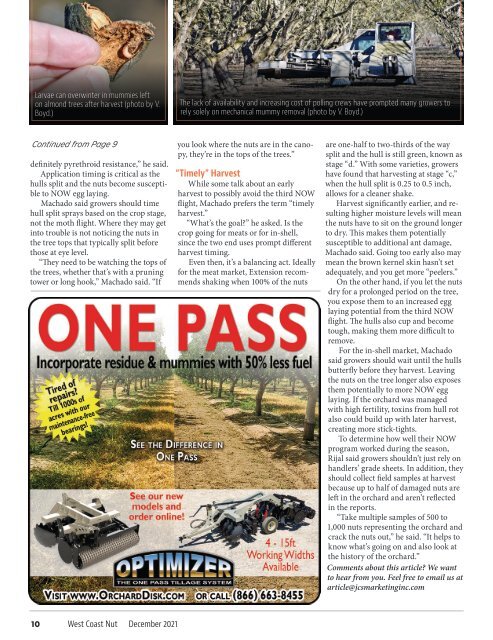WCN Dec e
Create successful ePaper yourself
Turn your PDF publications into a flip-book with our unique Google optimized e-Paper software.
Larvae can overwinter in mummies left<br />
on almond trees after harvest (photo by V.<br />
Boyd.)<br />
The lack of availability and increasing cost of polling crews have prompted many growers to<br />
rely solely on mechanical mummy removal (photo by V. Boyd.)<br />
Continued from Page 9<br />
definitely pyrethroid resistance,” he said.<br />
Application timing is critical as the<br />
hulls split and the nuts become susceptible<br />
to NOW egg laying.<br />
Machado said growers should time<br />
hull split sprays based on the crop stage,<br />
not the moth flight. Where they may get<br />
into trouble is not noticing the nuts in<br />
the tree tops that typically split before<br />
those at eye level.<br />
“They need to be watching the tops of<br />
the trees, whether that’s with a pruning<br />
tower or long hook,” Machado said. “If<br />
you look where the nuts are in the canopy,<br />
they’re in the tops of the trees.”<br />
“Timely” Harvest<br />
While some talk about an early<br />
harvest to possibly avoid the third NOW<br />
flight, Machado prefers the term “timely<br />
harvest.”<br />
“What’s the goal?” he asked. Is the<br />
crop going for meats or for in-shell,<br />
since the two end uses prompt different<br />
harvest timing.<br />
Even then, it’s a balancing act. Ideally<br />
for the meat market, Extension recommends<br />
shaking when 100% of the nuts<br />
are one-half to two-thirds of the way<br />
split and the hull is still green, known as<br />
stage “d.” With some varieties, growers<br />
have found that harvesting at stage “c,”<br />
when the hull split is 0.25 to 0.5 inch,<br />
allows for a cleaner shake.<br />
Harvest significantly earlier, and resulting<br />
higher moisture levels will mean<br />
the nuts have to sit on the ground longer<br />
to dry. This makes them potentially<br />
susceptible to additional ant damage,<br />
Machado said. Going too early also may<br />
mean the brown kernel skin hasn’t set<br />
adequately, and you get more “peelers.”<br />
On the other hand, if you let the nuts<br />
dry for a prolonged period on the tree,<br />
you expose them to an increased egg<br />
laying potential from the third NOW<br />
flight. The hulls also cup and become<br />
tough, making them more difficult to<br />
remove.<br />
For the in-shell market, Machado<br />
said growers should wait until the hulls<br />
butterfly before they harvest. Leaving<br />
the nuts on the tree longer also exposes<br />
them potentially to more NOW egg<br />
laying. If the orchard was managed<br />
with high fertility, toxins from hull rot<br />
also could build up with later harvest,<br />
creating more stick-tights.<br />
To determine how well their NOW<br />
program worked during the season,<br />
Rijal said growers shouldn’t just rely on<br />
handlers’ grade sheets. In addition, they<br />
should collect field samples at harvest<br />
because up to half of damaged nuts are<br />
left in the orchard and aren’t reflected<br />
in the reports.<br />
“Take multiple samples of 500 to<br />
1,000 nuts representing the orchard and<br />
crack the nuts out,” he said. “It helps to<br />
know what’s going on and also look at<br />
the history of the orchard.”<br />
Comments about this article? We want<br />
to hear from you. Feel free to email us at<br />
article@jcsmarketinginc.com<br />
10 West Coast Nut <strong>Dec</strong>ember 2021

















